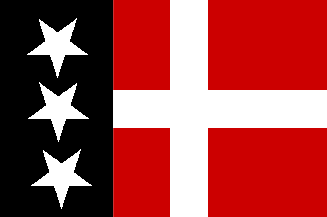
by Ivan Sache

Last modified: 2003-07-12 by dov gutterman
Keywords: arpitania movement | italy | cross | val daosta | savoy | aosta vulley | harpitanya |
Links: FOTW homepage |
search |
disclaimer and copyright |
write us |
mirrors
See also:
I found the flag of the "Movement Harpitanya", that
operates in Aosta Valley (Valle
d’Aosta) in Savoie.
Jaume Olle', 19 Febuary 1997
"Arpitany" is historical region of the arpitanian
language (I suppose that it never formed a separate political
entity). This includes roughly the Aosta valley in Italy, Savoy
(both departments) in France, and Romandy (French speaking
Switzerland). Arpitanian, also known as Franco-provenc,al or
Savoyan, is a latin language, making a "bridge" between
Occitan, Piemontese and French (aka Oil). As far as I know, it is
currently in a similar demographic situation as Occitan, i.e.,
still widely spoken, especially by older people in the
countryside, but regarded by most speakers to be
"patois", a lesser form of French. (That's why the
italian government's move to declare French instead of
arpitanian, as the official language of Val d'Aoste / Valle de
Aosta region left nobody satisfied...).
Naturally, there are intellectuals favouring the rehabilitation
of the language, its literary fledging, official protection and
use, dialectal standartization, speaker's consciousness and
terminology evolution. "Movement Harpitanya" might be
one of these organizations, I dont know. Their flag has clear
savoyan connections, and I wouldn't be surprised at all it it
show to be blue instead of grey. As for the unusual spelling,
with an "H", I really never seen it that way, but it
might the result of a (recent?) orthographic reform.
Antonio Martins, 20 May 1999
Franco-provencal is different from patois and different from
the language usually spoken in the area. I quote parts of the
juicy book "Dictionnaire du Chablaisien" by A. Depraz,
a collection of words specifically used in the Chablais (northern
part of Savoy) and contiguous areas:
".The root of French language is common Latin - source of
roman languages - used by Romans in all-day life and imposed in
Gaule by the conquestors, the colons and the merchants. This
Latin quickly evolved in different spoken languages, in regional
varieties or dialects, or even in more localized varieties, the
patois. This led to the birth of the well-known oil and oc
languages, to which we must add franco-provencal. These three
languages were influenced, respectively, by germanic inputs of
the Franks in North, Wisigoths in South, and Burgonds in our
region [Savoy]. In 1539, the order of Villers-Cotterets was
highly significant for the language history because French
instead of Latin was imposed as the official language to be used
for writing official documents. Thi